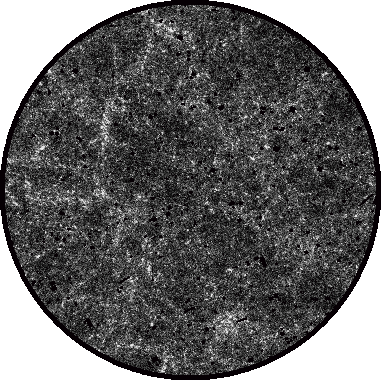
The center of the Universe is very near, but it will take a journey of five thousand words to get there.Chris Crawford (2005)

Some astronomers are part of an arrogant know-it-all crowd. They scorn the troglodytes who thought the Earth was flat; yet they are convinced that the Universe is flat. They disdain the ancients who believed quite logically that the Sun and planets revolve around the Earth. (Would we not be flung off into the heavens, if the Earth were spinning?
, the ancients asked. Would there not be a strong wind continuously blowing across the surface, if the Earth were traveling around the Sun? ....
) And these same know-it-alls ridicule more recent forebears who thought the Sun was in the center of the (Milky Way) Galaxy. (Which made sense because counts of stars found the same number in all directions.)
The moderns are determined not to repeat past mistakes. THE MILKY WAY IS NOT THE CENTER OF THE UNIVERSE!
they proclaim. But like most generals, they are fighting the last war. They do not realize that each war
has its own unique set of circumstances and must be strategized based on its specific conditions.
Believers in the Big Bang
theory of the origin of the Universe are confronted by a number of issues. But the chief two are called the Flatness Problem
and the Horizon Problem
. Let's look at both of these problems and some possible solutions.
The Flatness Problem concerns the apparent characteristic of the Universe that its density is such that there is no curvature of the space-time continuum–it is flat. Most cosmologists are certain that the Universe is flat. They have a need to believe and find evidence that the Universe has this peculiar property. According to Einstein, mass causes curvature–more mass, more curvature; less mass, less curvature.
flat–curvature is zero. The expansion will gradually slow but never completely stop.
Estimates of the density in the Universe yield a result very close to the critical value. It does not make sense that the density would be so close to the critical value–there must be a small calculation error and the true density must be the critical value–or so they believe. Now, here's the riddle: with all the possible positive values and with all the possible negative values, what causes the Universe to have the uniquely singular curvature of zero? But to me, the really big question is: how do they know what the critical value is–what density would cause the universe to be flat?
Density is mass per volume. If either the numerator or the denominator is wrong, then the calculation of density is erroneous. In fact there are problems with the measurement of both the numerator and denominator of density.
dark matter. (Actually
colddark matter, such as
MACHOs. Now some pursue
hotdark matter, such as neutrinos.)
red shift. Considering the long distances and large times required for light to reach us, are there intervening conditions (forces or matter) which would cause light to shift more or less than expected toward the red end of the spectrum?
We are caught in circular reasoning–we have to know the curvature of the Universe in order to determine the curvature of the Universe.
The Horizon Problem is that opposite ends of the Universe are too far apart to be causally connected and yet they are inexplicably identical. Gas released into a container will reach equilibrium, at which point all sub-volumes of the same size contain the same number of gas molecules. The gas is causally connected and the molecules are said to be in communication
with one another. When Cosmologists say that opposite ends of the Universe are causally connected they really are not talking about the distribution of galaxies–they are actually focused on Cosmic Microwave Background Radiation (CMBR).
There are paths which lead to resolution of the Horizon Problem:
communication. It is possible that there are inherent properties of the CMBR and the matter of galaxies which causes them to appear and behave similarly without having been in contact.
edgeof the Universe is thought to be very roughly 15 billion light-years from us. Another galaxy at the opposite
edgeof the Universe is also approximately 15 billion light-years away. Does this mean that these two galaxies must be 30 billion light-years apart–too far from one another to be causally connected? No–their separation depends on the curvature of space!!!!
So, the Horizon Problem is connected to the age and size of the Universe. To some extent the size depends on the age and vice versa. But putting aside circular reasoning, estimating the age and size of the Universe is like trying to guess someone's age at a carnival–not just year, not only month and day, but down to hour, minute, second–and then some. The Universe is around 15 billion years old and is thought to be about 100 billion light-years in size (estimates vary). So we are going to extrapolate back to the beginning of time and space and say that age and size are out of sync by 1% of 1 million trillion trillionths in time and 1% of 100 trillion trillionths in size? Breath-taking!
To solve the Flatness Problem and the Horizon Problem, Cosmologists have embraced Inflation Theory
. This postulates that shortly after the Big Bang (in the first 1 / 100 million trillion trillionth sec. after creation), the Universe went through a phase change when the strong force split from the other forces. This symmetry breaking released an enormous amount of energy–vacuum energy
with negative pressure. The Universe expanded at an exponential, super-luminal rate [faster than the speed of light]–growing in size 100 trillion trillion trillion trillion times. It expanded from 1 / billion trillion trillionths of the size of quarks and electrons upto the size of a grapefruit.
Inflation did two things: increased the size of the Universe so that it flattened out its curvature [like blowing up a balloon to Earth-size] and separated parts of the Universe which had been in communication [assumes Universe already in equilibrium]. Inflation Theory is, of course, backed up with a lot of heavy-duty mathematics. Belief in the Big Bang and Inflation Theory have not quite reached theological proportions, but they are close.
All this reminds me of the Ptolemaic System of planetary motions, which was also backed up by extensive mathematics and actually did achieve the status of theological belief.
retrogrademotion.
circles upon circlesapproach gets closer to the actual paths of the planets, but it is still not precise.
And so it goes–one fudge factor added on top of another. The problem was that the basic assumptions were wrong and no amount of tinkering could fix them.
In any event, the theoreticians define three types of Universe. For those of you who are really interested in this stuff, I include the following table with the attributes for each of the three Universe types: Closed, Flat, Open:
[Note:
These three triangles are important in understanding the curvature of space. They are obtained by drawing an equilateral triangle on a sphere, plane, and saddle, in that order. Eyeball the angles of the triangles:
Elliptical Triangle: If two lines are perpendicular (90º) to a third line, then they are parallel. But here the pairs of parallel lines converge and eventually cross each other.
Two models are commonly used to illustrate the expanding Universe. One is valid but not realistic; the other is realistic but not valid.
At long last and after much anticipation, we get to MY model. As far as I know this is an original concept. [Maybe some astronomer just held a press conference on a remote island last week to announce the same concept.] I find this model useful in coming to grips with all the issues discussed above. I will explain it in narrative form because I think this will make the model easier to understand. No proofs will be presented. This model is just another tool in helping to understand the ultimate reality of the Universe.
This is a model of the Universe–not a photograph. Obviously, the galaxies are grossly over-sized relative to the Universe. In actuality, individual galaxies are so miniscule they would not be seen at this scale. Further, they are countless billions of galaxies in the Universe, in addition to the seven shown. This is an attempt to keep things simple.
Since we are traveling around the
So far rather hum-drum and unexciting. But now things start to get interesting. It just so happens that there is an alien creature (Extra-terrestrial or ET) peering our way from the galaxy we call
We can see the Milky Way (
The thing you may find most puzzling is that the
[You may noticed that I have changed my convention for showing the galaxies in the South line of sight. I put
As noted earlier there are three possible types of Universe based on mass, size, and the resulting density–positively curved, flat (not curved), and negatively curved. Let's explore some more illustrations so we can better appreciate the curvature of space-time and the nature of the Universe.
Observers at
The third type is an open, negatively-curved Universe. I must admit I am not completely confident that I am correct about this. [But then, have you read a description of what the Universe looks like as you approach or orbit a black hole? In theory, you can see the back of your own head! The gravity is so strong, that gravity curves light so much, that light actually orbits the black hole!!]
I think my model is far superior to the spotted-balloon or raisin-bread analogies. The essential feature is that there are no edges or surfaces–everything is in the middle–at least from the perspective of any observer. All galaxies can expand or contract from all other galaxies proportional to distance between them. The direction of movement is multi-dimensional–that is, the galaxies do not all move in one direction. The model is realistic–there is no empty space in the middle. It gives insight into how all galaxies can expand away from each other without expanding away from an origin or central point.
On to the $64,000 question–where is the center of the Universe? It is everywhere; it is no-where. (This dualism is an often-repeated theme in these essays.) It is valid to state that there is no one unique place which is the center of the universe. It is equally valid to state that every observer is at the center of the observer's reference frame. This is more than a cute, semantic play on words–it has scientific merit. Einstein saw himself as a philosopher as much as a scientist. He employed
It is impossible to measure the Universe. It is impossible to measure any thing against itself. We can only measure one part relative to another part–whether space or time. As mentioned above, divining the age of Universe is like trying to guess someone’s age at a carnival down to very small fractions of a second. We cannot measure the curvature of Universe because our measurement tools are equally curved. We cannot measure the temperature of the early Universe–what with? If the forces of the early Universe were different (as postulated by Inflation Theory), no doubt other laws of physics were also–speed of light, gas diffusion, light equilibrium? The process for creating photons was definitely different–no atoms, no electrons.
The size and expansion of the Universe depend on a point of view. It is valid to think of every thing in the Universe as fixed in size and the Universe as expanding. But is also equally valid to think of the Universe as fixed in size and everything in it (including the laws of physics) as contracting. Irrational!! Does not make any sense! Defies understanding and senses (aka, conventional wisdom). Tell that to the ancients who believed it was impossible for the Earth to spin on its axis and to travel around the Sun.
My skepticism about the Big Bang and my complete disbelief of Inflation Theory are rather ironic. I am a staunch believer in God, but I tend to favor a kind of steady-state Universe–a concept which does not require a Creator. On the other hand, the Big Bang is a creation event. Nothing–then suddenly an infinitely small, infinitely dense, infinitely hot Universe. The Big Bang demands a Supreme Being. Here is my rationale. If God is powerful enough to create an in infinitely small, dense, hot Universe, then God is powerful enough to create a not-so-dense-or-hot Universe which was the size of a golf ball, a soft ball, a basket ball, or even a beach ball. God could have created the CMBR at any temperature and with any degree of homogeneity.
[I will be writing an article about the Big Bang and Inflation Theory, which will cover a host of issues and inconsistencies about our understanding of the Universe, not only the Horizon and Flatness Problems, but also the age, size, and density of the Universe, as well as the latest fads–like dark matter and energy. READ MORE: Big Bang and Inflation.]
My Universe is an undulating one. It is like waves on a three-dimensional ocean–part expanding, part contracting, part stationary–all slowly fluctuating from one condition to another. It is infinite in extent and eternal in duration. These words make it seem a bit more imposing than the reality. Basically, there is no space or time without the Universe–it IS the space-time continuum. This Universe has a God and its creation was not an event in the past. It is a continuing process which maintains the existence of the Universe. Why is this my Universe? 1) As far as I know, no one else this thought of this possibility. 2) I enjoy yanking the chain of the Astronomical Establishment.
Three Types of Universe
Attributes Closed Flat Open
Density > critical = critical < critical
Shape Elliptical Euclidean Hyperbolic
Analogy Sphere Plane Saddle
Curvature Positive None Negative
(back into self) (away from self)
Future Expansion, Expansion slows, Expands forever,
then contraction but never stops never slows
Size Finite Infinite Infinite
Time Ends Never ends Never ends
Triangle angles, sum > 180º = 180º < 180º
Circle, circumference < 2 pi Radius = 2 pi Radius > 2 pi Radius
Parallel lines Converge Parallel Diverge
<
means less than
; >
means more than
]
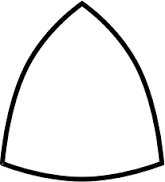
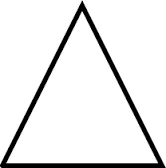

Elliptical 90º illustrates parallel lines converging
Euclidean 60º (illustrates nothing)
Hyperbolic 0º illustrates parallel lines diverging
Hyperbolic Triangle: If the angle between two lines is 0º, then they are parallel. But here the pairs of parallel lines diverge. (And they would wrap around in a circle, if continued.)
The latest evidence seems to indicate that the expansion of the Universe is speeding up–that means the Universe is Open. My condolences to the flat-universers
.
Models of the Universe
inside
or outside
of the surface.
We blast off in our crystalline (transparent) spaceship. At Warp speed (many, many times faster than the speed of light), we quickly arrive at our destination–midway between the nucleus of the Milky Way Galaxy and the two Magellanic Clouds (satellite galaxies)–far enough away from the Sun to get a clear, unobstructed view of the Universe. Gyroscopes stabilize our position. We appear to be in the middle of a gigantic sphere with billions of galaxies in random clumps near and far–some up to roughly 15 billion light-years away.
We begin to map the Universe by labeling our current position M
(for Milky Way). We peer straight ahead and find at the edge
of the Universe a galaxy which we call N
(North). We turn left and right and at the outer reaches find galaxies W
(West) and E
(East). We do an about-face
and view galaxy S
(South) so very far away. We look straight up overhead and identify the farthest galaxy as A
(Above). We squint down between our feet and call the most distant galaxy B
(Below). We have defined an orthogonal (right-angled) map of the Universe with selected galaxies at the six principal points of our spherical compass and put ourselves right in the Middle. Here is a bird's-eye view of our Universe:
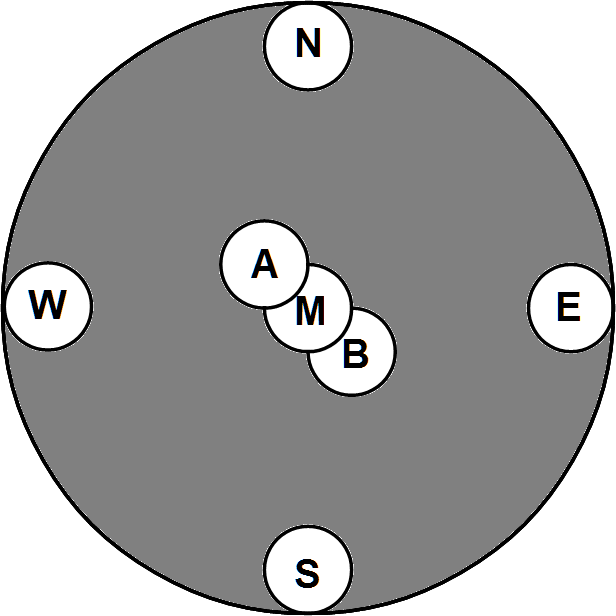
You can see the familiar North, East, South, and West. The three over-lapping galaxies in the center define the line of sight. The top-left galaxy is the closest and the bottom-right galaxy is the farthest. While the one in the middle is equi-distant from the other six galaxies–it defines the middle. So, in this view, we are looking from Above toward Below.
There are three principal axes: side to side, near to far, and up to down–each perpendicular to the other two. And each can be viewed in two directions. To help you become more familiar with this three-dimensional model, let's look at the views from the North, East, South, and West. And as a additional bonus, I'll throw in the Below view at no additional charge.
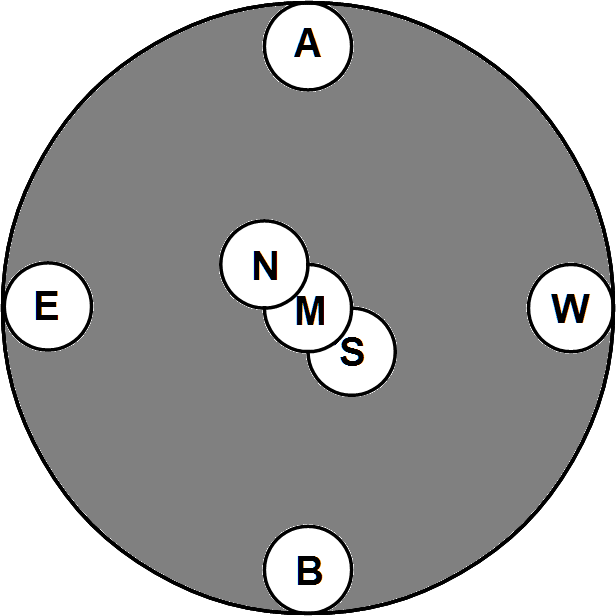
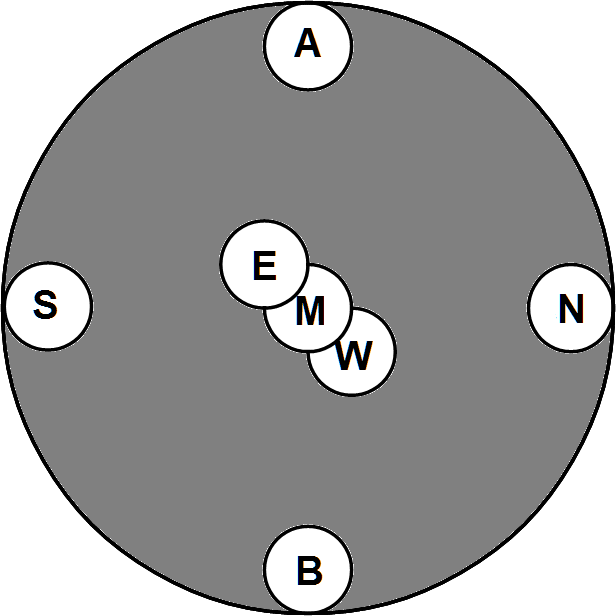
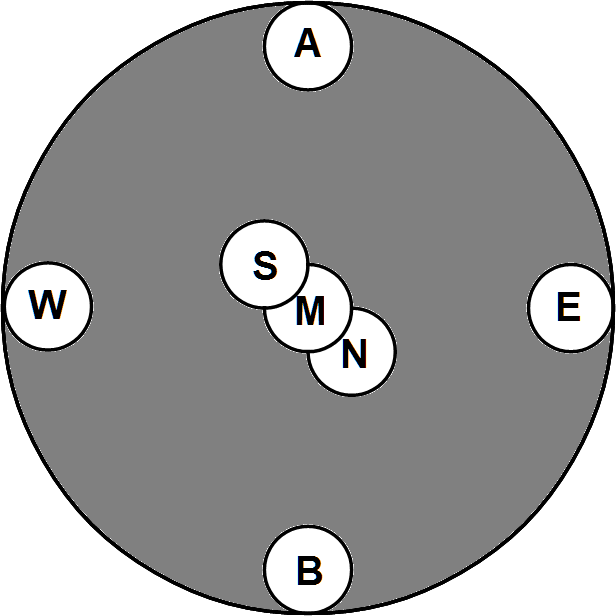
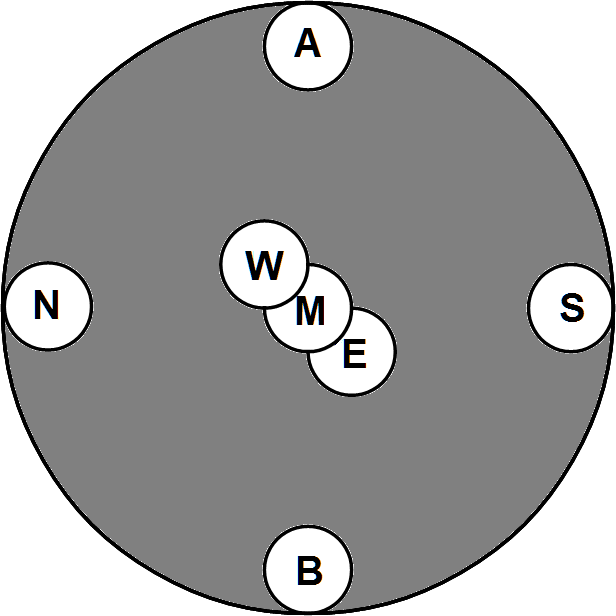
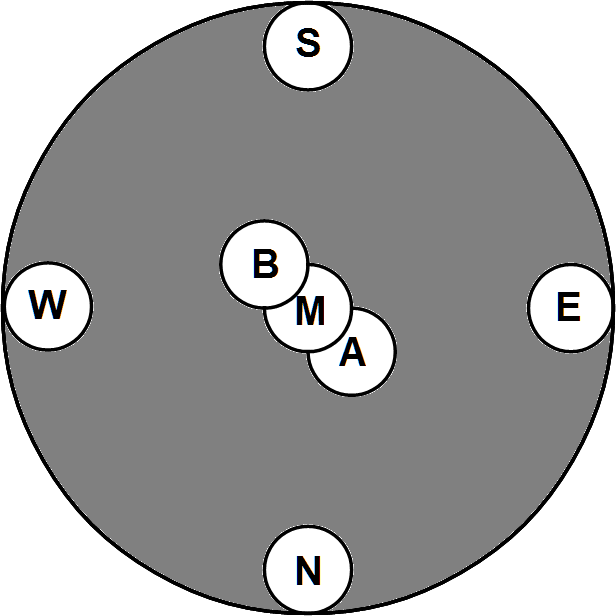
equator
of the Universe, galaxies A
and B
occupy the same positions in the North, East, South, and West views. Note that the North and South views as well as the East and West views are mirror images of each other. Because we are using two-dimensional images to illustrate three-dimensional reality, there will be some amount of ambiguity. This can be removed by using any two images from different views. We will only be using two views (Above and South–the two most natural) for the rest of this article.
Elliptical (positively-curved) Universe
East
(E). [Actually, it was studying the horizon of its Universe circa 15 billion BC, give or take of few million years.] It is not surprising that ET views the Milky Way on the west edge
of its Universe. ET contorts its torso (no neck, no head) to examine the Universe above. Off on the horizon ET spots the galaxy we call A
. ET contorts its torso to survey the Universe below. There on the edge, ET discovers the galaxy we label B
. ET twists its torso 90º to one side and the other and observes the galaxies we identify as S
and N
at the very edge. ET does not need to turn around because it has a photon receptacle in the rear of its torso. With this organ ET is able to perceive the only remaining galaxy and calls it EE
. To ET the Universe looks like this:
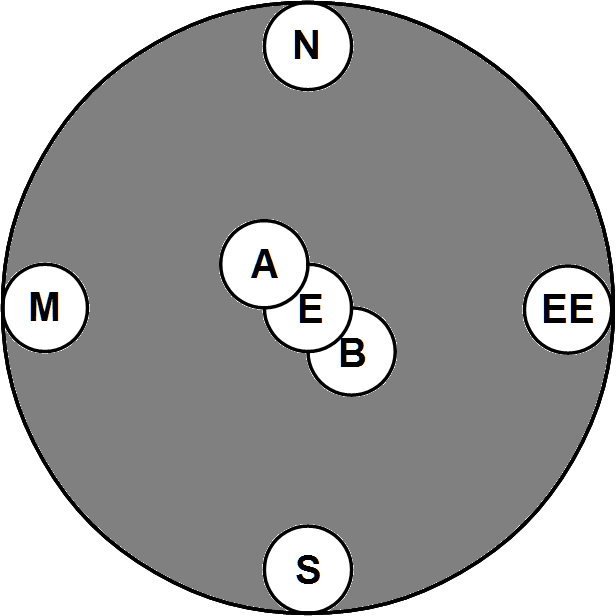
M
), ET's home galaxy (appropriately labeled E
), as well as new galaxy EE
(east of E
). But the other four galaxies (A
, B
, N
, S
)?? No way! This can't be right! Is this a bad joke? Did I make a mistake? Does this blow your mind? No. No. Maybe. The difference between our view and ET's view of the Universe depends on: 1) the type of the Universe, 2) the size of the Universe, and 3) the degree of curvature which the Universe has. What I have modeled is an elliptical universe, which has a small size and large curvature. Let's study this further by combining the two different views (ours and ET's) into one model:
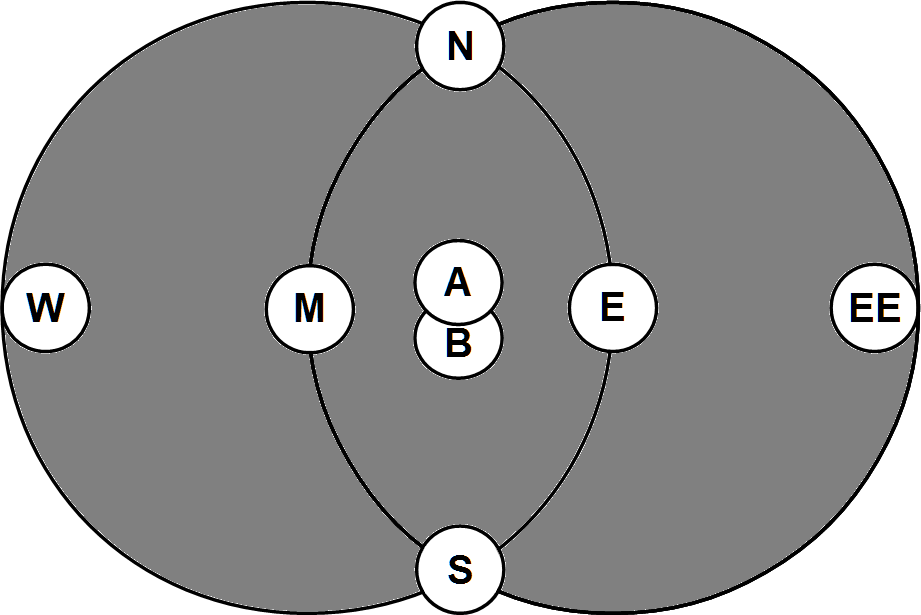
A
and B
galaxies are now located between us (M
) and ET (E
). This is an artifact of using two dimensions to show three dimensions. A
and B
, as well as N
and S
, are all equi-distant from M
and E
. This can be seen by viewing the Universe from the South:
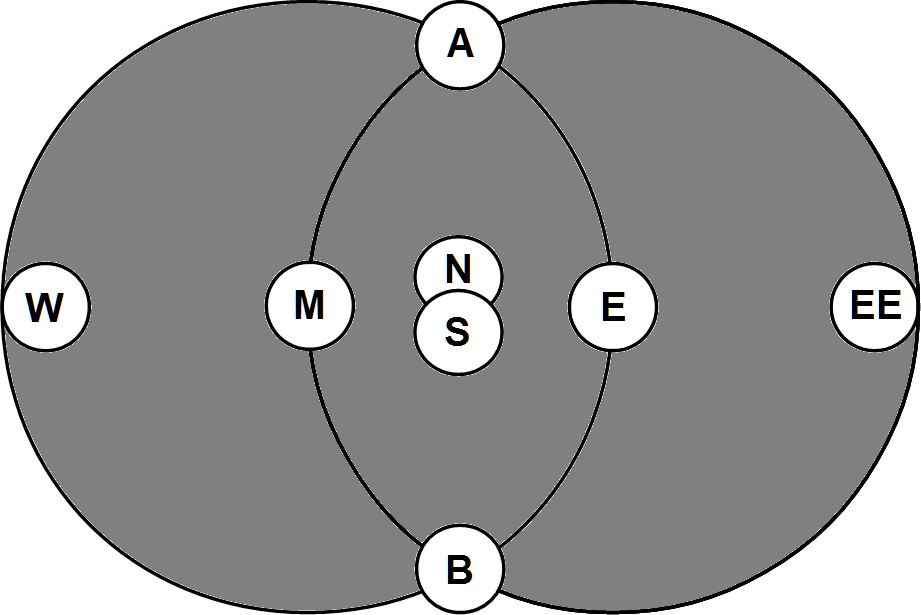
S
below N
which is the normal arrangement for maps. The important thing is that S
is closer to the viewing point and partially blocks N
.]
When viewing these two images together you can now visualize that galaxies A
, B
, N
, and S
are at the corners
of a continuous chain of galaxies which encircles the Universe equi-distant from galaxies M
and E
.
Further, if you follow the curved lines, which show the edges
of the Universe, from galaxies M
and E
to galaxies A
, B
, N
, and S
, then you will see the outline of an elliptical triangle, (shown previously). This illustrates the proposition that in elliptical space parallel lines converge. What start out as parallel lines at M
and E
, become significantly curved when they reach A
, B
, N
, and S
. This is why the views Above, Below, North, and South show the same galaxies for for observers at M
and E
.
The model is a valid illustration of a curved Universe, but not likely a historically accurate portrait of our Universe. The size and degree of curvature were selected to fit the illustration. You probably find this model a little mind-boggling. The problem is that we tend to see physical reality in orthogonal terms–three dimensions perpendicular to each other. We think of the Universe as a giant Rubik’s Cube–a 3-D Cartesian coordinate grid. But space-time is a four-dimensional continuum. Here are some concepts to help you become more comfortable with this curved Universe.
X
on the ground. Go exactly one mile North, then two miles East, and finally one mile due South. You have returned to the X
. Where are you? This is a real problem–it is not a trick word question about where the survivors are buried
. [I would like you to close your eyes and meditate about this for 5 minutes, but I am not naive enough to think anyone would actually do that. However, I am not soft enough to give up the answer right here. I will bury it in the text in a way which will be difficult for your eyes to scan forward and find the answer.]
The solution to the puzzle is another example of thinking outside the box
. We tend to think of the Earth's surface as a map–a two dimensional sheet of paper. Well, it is; but it is wrapped around the huge three-dimensional sphere known as Earth. The Euclidean geometry we learned in high-school no longer applies–we must think in terms of spherical geometry. [The solution to the puzzle lies below. You are looking right at it–just "select" the answer.]
If we were to plant a flag pole where the journey begins and ends, next station observers one, two, or three miles apart along a longitude one mile from that flag, and lastly instruct them to look due south, they would all see the same pole, which is found at the southern extremity of our planet. The analogy with the Universe is precise except for the number of dimensions.
=> X MARKS THE SOUTH POLE. <=
Euclidean (flat, not curved) Universe
The second type is the flat Universe. This is the familiar Cartesian orthogonal grid. Here the galaxies seen at A
, B
, N
, and S
by observers at M
and E
are NOT the same. So I have introduced additional galaxies and identified them as AA
, BB
, NN
, and SS
:
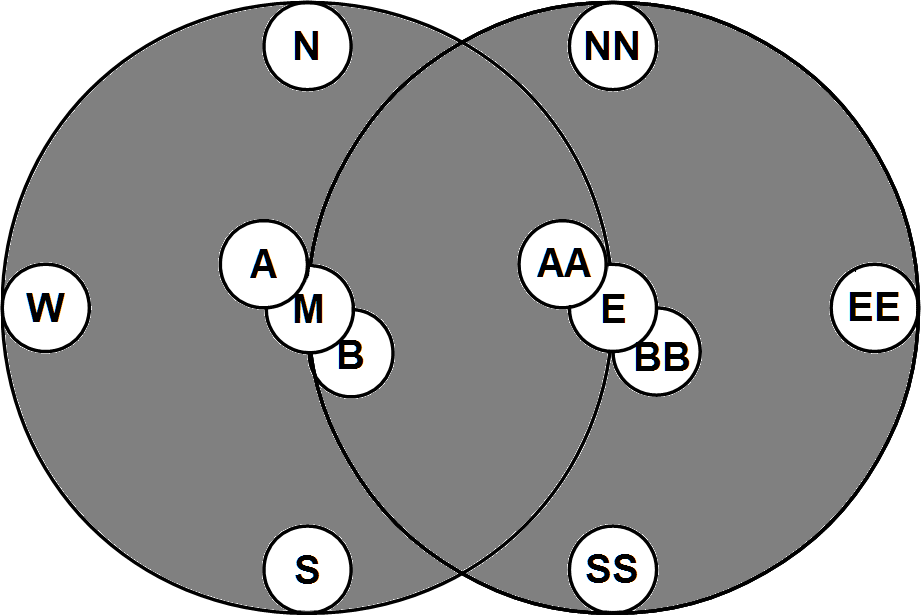
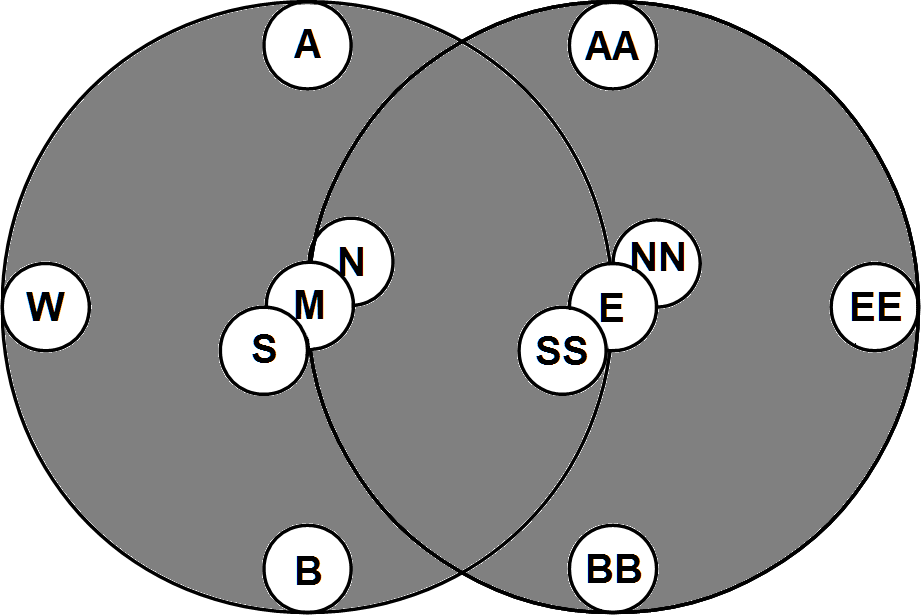
M
cannot see galaxies AA
, BB
, NN
, SS
, and EE
. And observers at E
cannot see galaxies A
, B
, N
, S
, and W
. A
And E
can only see the galaxies which are within their Universe
. (Keep in mind that we could draw similar diagrams for M
and observers at A
, B
, N
, S
, and W
. And also for every other pair a galaxies in the Universe. It never ends.
Hyperbolic (negatively-curved) Universe
This is not much different than the Euclidean (flat) Universe in terms of what galaxies can be seen from which galaxies. However, galaxies A
, B
, N
, and S
appear to have moved
behind
or beyond
galaxy M
; and galaxies AA
, BB
, NN
, and SS
also appear to have moved
behind
or beyond
galaxy E
. This is caused by the rule of parallel lines diverging in hyperbolic space. If you take the hyperbolic triangle (shown previously) and place one of the three tips on galaxy M
(both above and below M
), you will see that the left-hand side curves away to the left. If you do the same thing with galaxy E
, you will see that the right-hand side curves away to the right. So what starts out as two parallel lines at the tip diverge away from each other, as theory predicts.
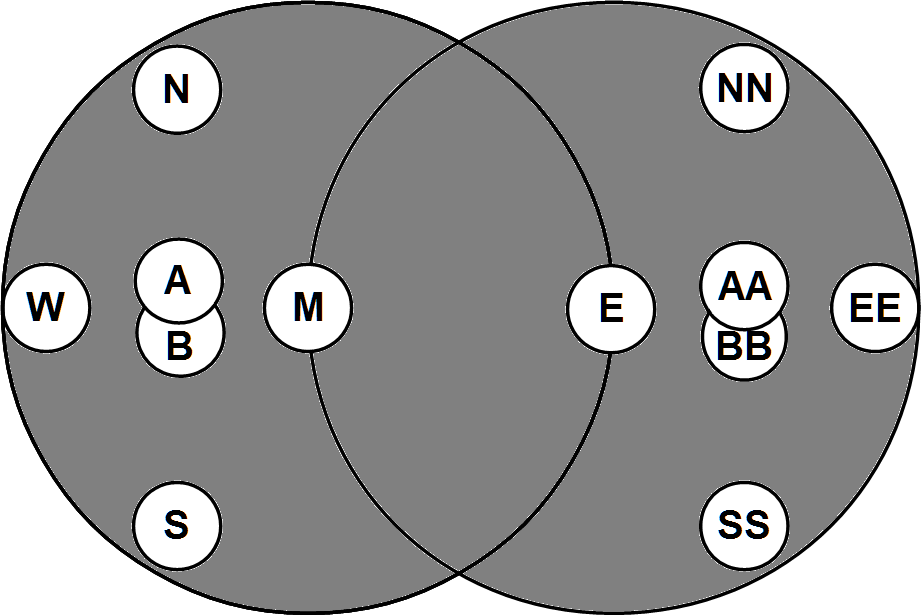
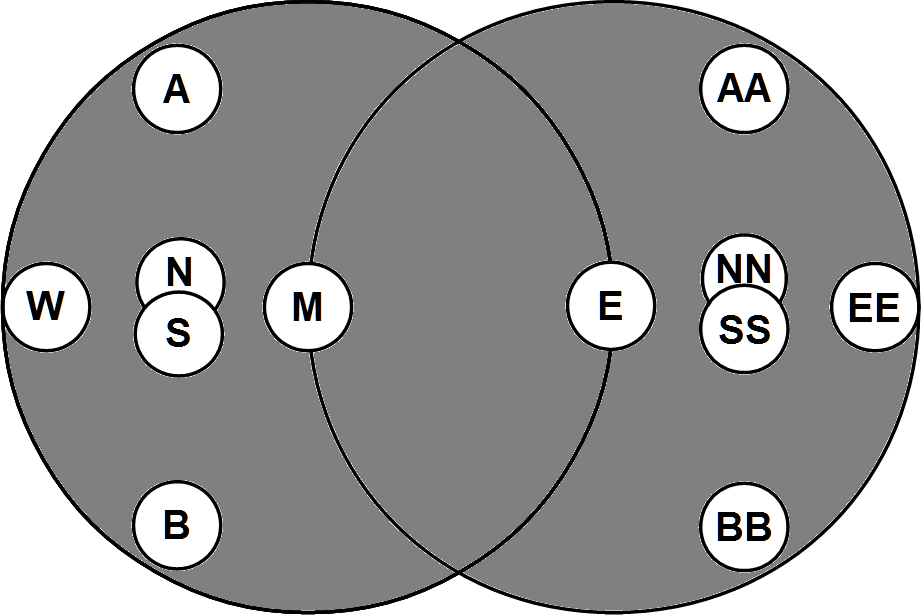
Summary of Models
The implication of the positively-curved Universe I have illustrated is that objects are closer to each other than they appear. Thus, the volume of the Universe is smaller than thought and the density is larger than thought. Larger density creates larger curvature. The Universe will expand and then contract. Of course, the latest evidence is that the Universe is expanding at an ever increasing rate. This could be caused by a negatively-curved Universe or by anti-gravity, vacuum energy, or some such fifth
force.
Center of the Universe
gedanken experiments to explain his concepts. To demonstrate that the speed of light is constant he used a high-speed train equipped with mirrors and lights. One observer rides in the train; another is stationary along the tracks. The observers see different realities–which observer's view is more correct? Both!
Let me continue with this philosophical view a bit further. Philosophers have argued about the nature of reality for more than two thousand years. Is it objective or subjective? I have come to the point of view that it is almost all subjective. The matter of the space-time continuum is mostly all plasma (ionized gas of positive atoms stripped of free, negative electrons). It is our mind which subjectively forms this plasma into stars, and nebula, and globular clusters, and galaxies, and clusters of galaxies, and the Universe. What is real to us is what we think is real. If we see ourself at the center of our Universe, then we are at the center of our Universe! [READ MORE: Reality and Existence.] So now let us see if we can define our Universe in more scientific terms.
I want to evoke something like the reciprocal of the Heisenberg Uncertainty Principle, which states that an observer cannot simultaneously know position and momentum of elementary particles. My Universal Uncertainty Principle
states that no two observers can simultaneously know the same set of facts about the Universe. The location, velocity, direction, and age of galaxies are different for each observer. Knowledge is different because of the observer's relative location and the slow
speed of light. [Would I be too clever to call this Universal Relativity
?]
Every observer occupies a unique position in the space-time continuum. Therefore, each observer's Universe is unique and different from every other observer's Universe. Two galaxies, which appear near one another to one observer, will appear far apart to another observer, because they have moved. Two galaxies, which appear the same to one observer, will appear at different stages of evolution to another observer. What appear as two galaxies to one observer will appear as one merged galaxy to another observer. These differences are not because the observers have different locations with different viewing perspectives. Rather it is because no one can completely know the Universe as it exists at any point in time. Once again it is time, time, time.
Every observer perceives the galaxies expanding away from the observer's position. We are at the center of our Universe; ET is at the center of ET's Universe; these two Universes overlap but they are different and distinct; in our Universe we see the Milky Way as it is now (give or take a hundred thousand years) and we see ET's galaxy how it was and where it was 15 billion years ago. This is the reality of the four-dimensional space-time continuum in which we exist. ET observes its home galaxy as it exits and the Milky Way how it was and where is was 15 billion years previously. This is ET's reality. It is impossible for us to know what ET observes, and vice versa.
No two observers experience exactly the same Universe. The Universe of Columbus and Copernicus is virtually indistinguishable from ours. An observer on the far side of the Milky Way (100,000 light-years away) would experience a Universe almost exactly the same as ours. An observer in the Andromeda Galaxy (a few million light-years away) would experience a Universe only slightly different from ours. Observers in galaxies A
, B
, N
, S
, and W
would experience a Universe quite different, but not completely different. Galaxies rotate. They move along non-linear paths. They collide and merge. They are swallowed up by black holes. They age–stars are born and die; gas and dust clouds condense and dissipate. The Universe evolves with time. You are at the center of the only Universe you can ever know. Welcome home.
[You may also be interested in learning about the Seven Giants who have shaped our evolving view of the space-time continuum: Earth => Solar System => Galaxy => Universe. Much of their work addressed the issue of the Center
. READ MORE: The Seven Giants]
Contents
![]() Feedback
Feedback